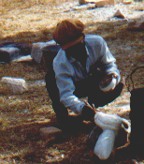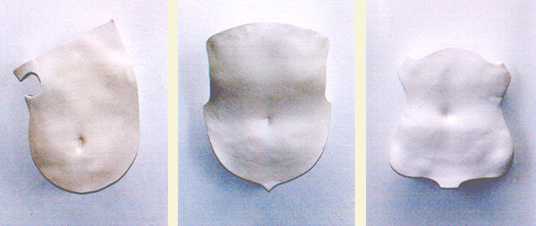|
|
|
| ||
| Espaņol |
Currently only excerpts & illustrations from the last 13 issues (numbers 43 to 55) are on this site. Scroll down to view the September 1998 issue. Click on the numbers to view other issues. Info about the current book on the arts | |||||||||||||||||||||||||||||||||||||||||||||||
| Contents List | |||||||||||||||||||||||||||||||||||||||||||||||
| excerpts & illustrations (The full articles are only available in the printed magazine. Click on "subscribe" for more info.) |
 |
56 |  |
55 |  |
54 |  |
 |  |
53 |  | 52 |  |
51 |  |
 |
 |
50 |  |
49 |  |
48 |  |
47 |  |
 |  |  |  |
 | ||||||||||||||||||
 |
 |  |
 | ||||||||||||||||||||||||||||||||||||||||||||
| 46 |  |
45 |  | 44 |  |
43 |  |  |
 | 42 |  | 41 |  | 40 |  | 39 |  |
 | 38 |  | 37 |  |
36 |  | 35 |  |
 |  |
34 |  |
33 |  | 32 |  | 31 |  | |||||||||||
number 45
|
|
Artist Profilespages 3 - 4 Biggy Kapeta, sculptor, Zimbabwe. |

Biggy Kapeta polishing a sculpture. |
||||||||||||||||||||||||||||||||||||||||||||||||||||||||||||||||||||||||||||||||||||||||||||||||||
|
Biggy Kapeta often works on a large scale in the hardest stones and his main source of inspiration
is a belief in his own culture. Most of his sculptures are sold in galleries in Europe and he earns his living from the sales
of his work. Currently he works from his home in the rural Chiweshe area (168 km from Harare)... In 1991 he started developing a culture centre where visitors can came to stay and to learn about sculpting... |

Biggy Kapeta´s sculpture garden, February 1998.
|
||||||||||||||||||||||||||||||||||||||||||||||||||||||||||||||||||||||||||||||||||||||||||||||||||
|
pages 4 - 6. Susan Lewis Wright, singer and songwriter, U.S.A. The direction of my music has changed, from my first album, which was generally folk and pop, to the latest album, which is mostly based on or inspired by the Bahá´í Writings, and my audience has changed as well. I perform mostly on college campuses and never in bars... Between humorous songs, and songs like I live in my dreams, which has the audience in tears, and Create in me a pure heart, adapted from the prayer, and written with lots of major sevenths, I've found a rather unique audience- people in recovery, New Age folks ... |

|
||||||||||||||||||||||||||||||||||||||||||||||
|
Calling all colors, a reggae tune and Turn this world around, an R&B dance tune are incorporated into performances where race unity is the theme. You can hear her music at: http://electricstores.come/susan The CDs Down in Mexico and Bird cost US$15.95 each, plus postage and packing (US$2 or US$4). Email Susan at: gizmopro@usa.net For more about her two music CDs, Down in Mexico and Bird on this site. pages 6 - 7 Ian Kluge, poet/writer, Canada; part two. Since age 30, I have increasingly focussed on writing and perfecting my craft as best I can. My file drawers are literally packed with all kinds of work; plays, a novel in 'postmodern' style, poems of all kinds ranging from haiku to 70 page long poems and even an opera libretto... ...Five of my plays have been produced in various towns and cities in British Columbia in addition to one short film, A poet of the wilderness (1997) shown on national cable TV in Canada... Contact Ian about his books or CD of poetry and music at: iankluge@netbistro.com |
|||||||||||||||||||||||||||||||||||||||||||||||
|
pages 7 - 8 Joke van Stuijvenberg, visual art, The Netherlands. |
|||||||||||||||||||||||||||||||||||||||||||||||

dust house, 1998,
detail of an installation by Joke van Stuijvenberg, The Netherlands. |
|||||||||||||||||||||||||||||||||||||||||||||||
|
...She made casts of the abdomens of nine people and recast these in the shape of heraldic shields, and hung these along the walls of an Eastern German castle. These shields evolved from the medival ages as symbols of identity, while serving as armour. In reproducing the sensual surfaces, Joke has replaced the protective layer with an aura of the intimate. Here the shields were emanicipated from their macho associations, and became symbols of vulnerability... |
|||||||||||||||||||||||||||||||||||||||||||||||
Poemspage 15 my ancestors ate God in the church now my mother lives in sacramento and i live in the city of the crosses these are still sacred times and places altho we no longer eat God we still like to inhale the fragrance of His robe by Bobby Mitchell, U.S.A. Declaration of the Bab and the tui by R. J., New Zealand. The sun swollen and angry red by Eddie Hall, South Africa. |
|||||||||||||||||||||||||||||||||||||||||||||||
Articlespages 9 - 12 The realm of possibility. Harmonizing fact and fiction: Part 3by Kathleen Hite Babb, Japan....there are those who strongly feel that ´fact is fact, and fiction is fiction; and never the two should meet´. On the other hand, however a wealth of enduring literature proves otherwise. As early as 1844, we find Alexandre Dumas combining reality and imagination in his Three musketeers. For the sake of drama, he ascribes movements to such historical renowns as Cardinal Richelieu, King Louix XIII of France...movements which most likely never happened... In 1972, E.L. Doctorow´s Ragtime was published, a novel in which fiction and fact are carefully interwoven as the story´s imaginary personae interact with Henry Ford, Harry Houdini, Sigmond Freud and Carl Jung... Despite this literary legacy, objections continue. In 1993, a historical novel appeared, Vindication by Frances Sherwood. In the author´s note at the very beginning, Ms. Sherwood informs the reader: Vindication is a work of fiction. It is based on the life of Mary Wollstonecraft (1759 - 1797) and her contemporaries. They were an inspiration thanks to which an imaginative world of its own came into being. Margaret Forster, a biographer, took issue with this ´imaginative world´ in her review of the book that appeared in The New York Times book review. This review subsequently drew a response from the writer Russell Banks. He asserted: ...a novelist uses the characters and events that appear in history and biography (and autobiography, news accounts, dreams, gossip, purloined letters, journals or anything else that comes her or his way) and adapts and deploys them to fit the strict purposes of storytelling. Whereas a novelist is primarily concerned with creating in language a morally coherent universe, a biographer or historian seems to be concerned instead with establishing Ms Foster´s ´received truth´ - a dignified and valuable task to be sure, but no more the job of a novelist than than of a poet, painter, film maker or musician...(New York Times, August 1st, 1993) This is an issue relevant not only to the secular world. As with Bahá´ís, it has also been a concern in Shi´ite Islám (with regard to their passion plays, particularly those involving the grandson of the Prophet Muhammad, the Imám Husayn)... Read the whole article at: http://www2.gol.com/users/kbabb/realm.html | |||||||||||||||||||||||||||||||||||||||||||||||
Finding the music of Qawwali: Part 2by Kevin Tilbury, Lithuania. Indian music has: a main melody line with an accompaniment; a drone, which is based on the first, fourth, fifth or eighth note of the scale; an accompanying melody line, which echoes the phrases of the main instrument or voice; and a precussive line, which is a time keeper, and is also used for rhythmic variations and improvisations. A raga is based on the idea that certain characteristic patterns of notes evoke a heightened state of emotion There are thousands of variations and uses of ragas. Some are played at certain times of the day, the month and year, other on special occasions, from marriage to making rain. There are masculine and feminine forms of the same raga, each with their own texture and results... ...Bhajans were popular Hindu religious songs taught by the poet singers to the devotees. Here there is a link with the wandering Sufis of the Middle East and the poet-singers of Hinduism...I heard my best example of bhajan at a Christian ashram in Pune on Christmas Eve. Nine Indian Hindu women came to sing the stories of the birth of Hindu dieties, which fitted in nicely with the birth of Jesus. With harmonium and tabla and hand bells, they sang for about two hours. A Brahmin priest said: Bhajans are a communication with God. They are intended to produce a hypnotic effect. In the villages, they sing all night and people go into a trance. It cleanses you. The ashram was started in raj times, when Hindus who converted to Christianity had to convert also to raj dress -social customs that were anti-Indian. They were often shunned by their Indian families and friends so that ashram functioned to bring the two cultures and religions together...also for Christians to understand the Hindu religion. Christian music is basically Indian raga, hymns sung in the dialect of each region. In the south of India, the old Syrian chant brought over by St. Thomas is still sung... The relationship between Shamanism, Bon and Lamaism is very close indeed: skeleton dances, sacredness of bones (bones being used as musical instruments), the use of the drum. All have been preserved in Tibetan Tantric Buddhism. The Tibetan nuns teach each other using the ritual of clapping. One hand represents ´compassion´ and the other hand ´wisdom´... Short Storypages 13 - 15
The Last Halloween at The Littlest Angel
by J Sparrowhawk, U.S.A....Burgeoning suburbs of medium priced homes encroached on the desert in three directions. The fourth was too close to the river and to the border with Mexico. Here, the barrios were -ragged splashes of dirt-colored shacks housing the nameless poor, the hardened hands who put food on a thousand tables. The barrios were full of mothers tired of being baby factories and of children whose noses pressed against bakery windows. Whose eyes stared longingly at the latest toys at Save Mart or at Fun Or Else. The youngsters seldom attended school. They worked as extra hands in the farm fields. The town priests had, as youths, soaked up All Hallow´s Eve´s tales of witches dancing their hideous nakedness about hellish fires and tales of the groaning and wailing shades of suicides and murderers. As adults, the priests imprinted these same tales in the minds and hearts of the barrio´s young. The kids know the mysteries of this night and would not dare wander about in imitation of the dead. The barrio kids would have no part in the little plays that the uptown young enact that night. Yet they knew the names of the ghosts and demons in the dark places along the river... Photographs and Illustrations of work by:Chuck Egerton, U.S.A, Joke van Stuijvenberg, The Netherlands, Emrys Miller, Canada, Jaromar Svozilik, Norway, Kevin Tilbury, Lithuania, Biggy Kapeta, Zimbabwe, James Bennett, U.S.A. |
|||||||||||||||||||||||||||||||||||||||||||||||
Translations, editing, layout, by:Kathleen Babb, Japan, Alison Marshall, Aotearoa / New Zealand, Steve Marshall, Aotearoa / New Zealand, Sonja van Kerkhoff, The Netherlands. |
|||||||||||||||||||||||||||||||||||||||||||||||
Arts Dialogue, Dintel 20, NL 7333 MC, Apeldoorn, The Netherlands.
http://Bahá´í-library.org/bafa email: bafa@bahai-library.com |
